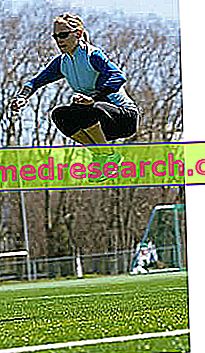Middle-distance, in all its specialties, is considered a resistance sport ... where resistance can be understood as a conditional ability or a specific expression of muscular work.

The resistance in middle-distance training of athletics
Resistance depends on several factors:
- Efficiency of cardiocirculatory and respiratory systems
- Efficiency of the nervous system and the muscular system
- Volitive and emotional capacity
Resistance can be differentiated in various ways; the first distinction concerns the general and the special one.
- The GENERAL refers to the ability to perform for a long time a sporting exercise that engages different muscle groups; it depends above all on the efficiency of the cardiovascular and respiratory systems and constitutes the athletic base to be developed above all in young athletes; it is identified with the aerobic capacity and is characterized by the balance between oxygen intake and its consumption.
- The SPECIAL resistance indicates the ability to withstand a specific type of work with maximum commitment; the special resistance is of different types:
- Long-lasting resistance: affected capacities: strength and aerobic power; duration> 8 ', mainly aerobic
- Medium duration resistance: mixed work: 2-8 'duration with aerobic and anaerobic lactate
- Short term resistance: lactic resistance: 45 '' - 2 '; predominantly anaerobic lactate and requires strength and speed
- Strength resistance: long-lasting strength; requires LOCAL high muscular endurance capacity
- Resistance to speed: maximum or sub-maximal intensity; almost exclusive commitment to the lactic acid anaerobic mechanisms.
All forms of special resistance are present in the various middle-distance specialties and their combination participates in achieving maximum athletic performance.
Strength: an essential component of resistance for middle-distance training in athletics
In the training of special resistance, for a long time, the development of the cardiocirculatory and respiratory aspects has been placed before all other abilities; however, the limit in endurance performance is mainly MUSCULAR. In fact, what matters is not so much the amount of oxygen that reaches the muscles (which is also difficult to modify), but the ability of the same to be able to use it through the "cellular respiration" of the fibrocells. The goal is to engage the largest possible number of muscle fibers in the oxidative energy metabolism, both the slow ones (type I - motor units S), and the intermediate ones (type IIA - motor units FR); these fibers adapt by increasing the VOLUME of the MITOCONDRI and the density of OXIDATIVE ENZYMES. The cardiac factor and the circulatory factor (capillarization) are however very important but NEVER limiting.
Resistance is therefore the synthesis of two phenomena: muscular contractile force and energy supply; on the other hand, the coordination skills that allow the acquisition of a correct running technique and the possession of an economic gesture are also essential.
Characteristics to train for the middle distance run in athletics
The middle distance runners must therefore develop ALL THE CHARACTERISTICS that allow them to face the different ATHLETIC and METABOLIC NEEDS; In short:
- Aerobic resistance: aerobic power and specific resistance, to support the run for as long as possible but with greater speed of execution
- Lactic acid capacity and power: to sprint as effectively as possible in the final as well as, in 800m races, to keep the running speed as high as possible
- Articular mobility, flexibility and coordination: to improve the technique and make the gesture more effective and efficient
- Muscle strength: above all fast and resistant, to improve speed and support fatigue more; it is therefore an essential prerequisite for any form of resistance and, as can be seen by examining speed training in athletics, is the basis of the speed of execution.
Many trainers do not share the importance of developing strength for resistance training, as several elite athletes have achieved maximum results without the help of barbells. However, they too must admit that some specific exercises such as the uphill race have as their first objective the increase of the same strength which, in my opinion, can certainly be developed effectively through general exercises subsequently (and duly) transformed into the specific gesture. Obviously, the use of general techniques CANNOT and must not replace in any way the special and / or specific athletic gesture.
It is also logical that, in the youth categories, the training priorities are different as the goals are different; young athletes do not aim to achieve the maximum possible performance, but rather to achieve the qualities necessary for future athletic construction (exercises for conditional and coordinative skills).
We conclude this introduction to middle-distance training in athletics highlighting that, among the different disciplines ( fast midway: 800m, 1.500m and extended middle distance: 3.000m, 3.000m hedges, 5.000m, 10.000m), the energy demand changes radically and with it also energy metabolisms. In none of these it is possible to disregard the aerobic or anaerobic metabolism but, while in the 800m the anaerobic mechanisms (both alactacid and lactacid) constitute half of the potential performance, in the 1, 500m the importance of aerobic power assumes an even more important role than it grows further as the distance increases; considering a 10.000m, the race speed does not differ too much from that corresponding to the anaerobic threshold and, together with the lactacid metabolism, the ability to develop muscular strength also loses importance.
It is however possible to state that the element attributable to ALL middle-distance disciplines for athletics is the AEROBIC POWER which, while in fast races facilitates the dilution of the effort, ensures the maximum execution speed for long races.
Bibliography:
The track and field coach's manual - Part one: general information, races and march - Studies and Research Center - pag. 69-84.



